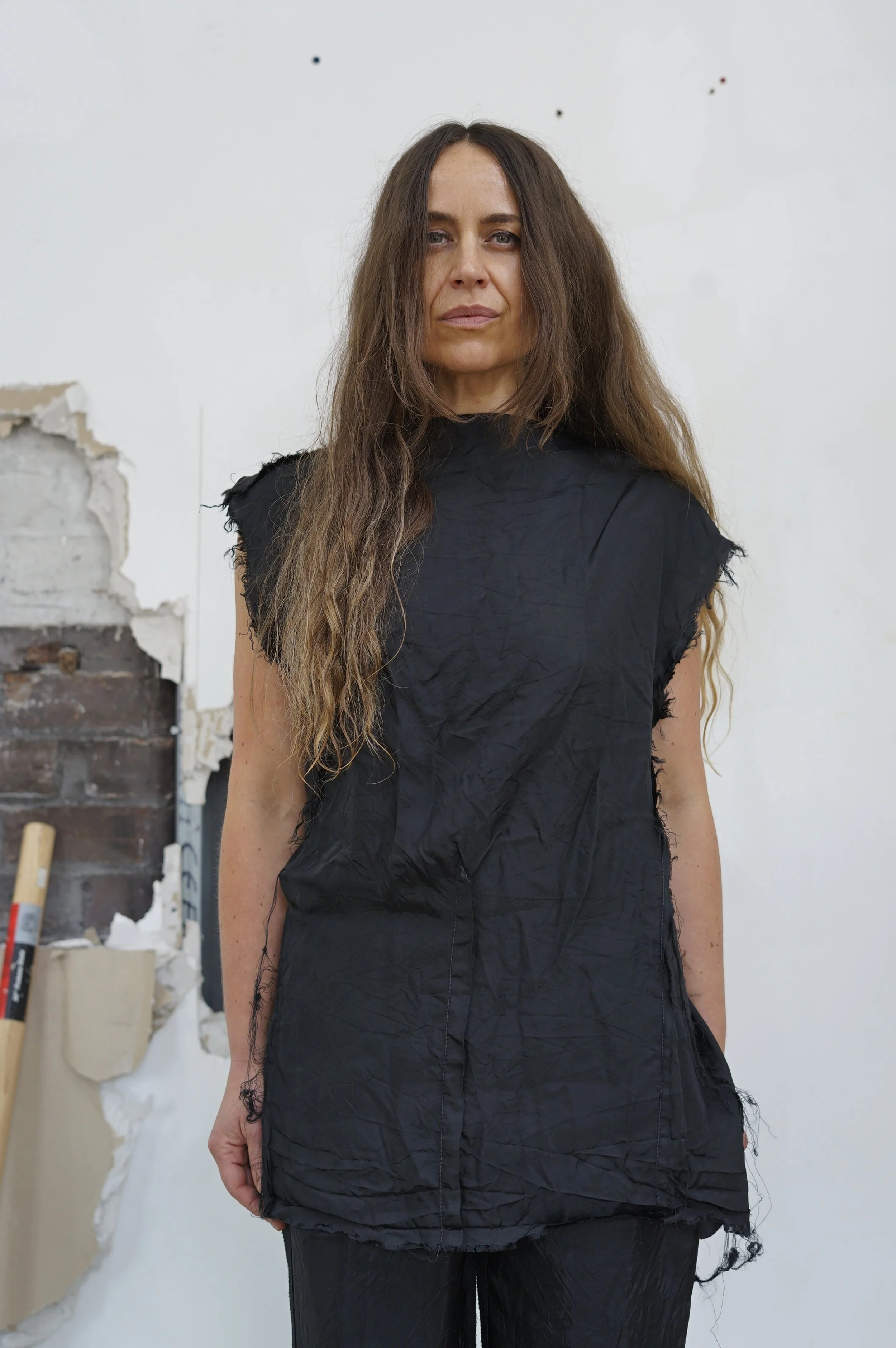The artistry of the creative renewal.
I wanted more than labels—
I wanted transformation.
In conversation with the artist, designer and founder of KUDERA, a(r)telier about the importance of choices in fashion.
Alena photographed by Niamh Josee, wearing Jack Hilton’s graduate collection.
You seamlessly fuse luxury and sustainability. How did you develop your interest in circularity in fashion?
I grew up in a small village in communist Czechoslovakia, where clothing options were scarce. As the youngest of three, I mostly wore hand-me-downs—often polyester and far from fashionable. Occasionally, relatives who worked abroad brought us their children’s unwanted clothes, and my siblings and I would fight not just for the garments but even for the foreign-branded plastic bags they came in.
My sister and I began stitching the exotic brand labels we carefully unpicked from the exiting second-hand haul onto the outside of our clothes. We proudly showed them off, claiming the title of the most fashionable duo in the village—though, admittedly, the competition wasn’t exactly fierce.
But I wanted more than labels—I wanted transformation. With my grandmother’s sewing machine (and her lace curtains, which I now regret cutting), I started reinventing what I had.
That experience taught me to value quality, longevity, and craftsmanship. I’ve always hated waste but loved reinvention and contrast. Circularity became a natural expression of that— taking something old and/or unwanted and turning it into something new and desired.
Deconstructed suit by KUDERA a(r)telier, styled by Alena.
Tell us more about the process of deconstructing the garments. There are misconceptions about the quality of such work and the level of skills required.
Deconstruction demands the same—if not greater—level of skill, craftsmanship, and knowledge as traditional construction. While construction follows established rules and techniques, deconstruction requires a deep understanding of those rules, enabling precision in bending or breaking them. It’s about dismantling a garment without destroying its integrity—respecting the craftsmanship while reinventing its form and identity.
Each material tells its own story and must be handled accordingly. Wool and silk, for instance, are entirely different creatures—each requiring unique cutting methods, machinery, and care. True deconstruction lies in mastering these nuances and transforming the familiar into something strikingly new.
What do you look for when sourcing/validating base products for your collections?
I look for quality above all—natural materials like wool, silk, and linen, and garments with timeless craftsmanship. The older the piece, the more character and integrity it tends to have. Many of my base garments find their way to me organically, and over time I’ve built a curated collection of textiles and clothing worth saving.
Looking ahead, collaboration with brands and manufacturers of high-quality goods is key—transforming unsold or discarded pieces into new creations and rewriting their fate from landfill to legacy.
#01 edition by KUDERA features deconstructed goods, carefully selected for their good quality source material and longevity potential. Model: Serena
Your experience in theatre costume design and art has a big impact on how you work and make your apparel.
I see the body as a canvas and clothing as a language. My theatre work amplifies a creator’s vision—making their message louder and more vivid. My apparel, on the other hand, is my own dialogue with the world—an invitation for others to join the conversation by wearing my pieces. In my art, I’m liberated from rules and function—free to experiment without the constraints of wearability or comfort that guide my apparel. It’s all part of the same creative voice—just expressed through different forms.
The WASTED exhibition by Alena Kudera is a whimsical exploration of material, form and structures.
Kudera Label promotes slow fashion and conscious shopping. Is this the future of the industry? What are your goals?
I truly hope it is the future. Fast fashion is destroying our planet, feeding profit-driven systems that create polyester mountains and devastate natural ecosystems.
KUDERA stands for conscious craftsmanship: using existing garments, deadstock fabrics, and materials of transparent origin. Each piece is designed with longevity, quality, and individuality in mind. Unexpected yet refined, elegant yet effortlessly cool.
I see the brand as the couture house of conscious fashion. A place where people come not just to shop but to experience something meaningful that’s crafted with intention and designed to nourish both aesthetically and ethically.







